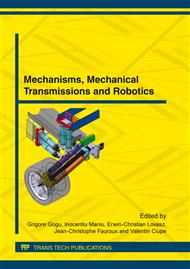[1]
C.M. Angle, Design of an Artificial Creature, Master's Thesis, MIT, (1991).
Google Scholar
[2]
J. Ayers, J. Witting, Biomimetic approaches to the control of underwater walking machines, Phil. Trans. of the Royal Society A, 365 (2007), p.273–295.
DOI: 10.1098/rsta.2006.1910
Google Scholar
[3]
N. Cimpoesu, S. Stanciu, I. Doroftei, I. Ionita, V. Radu, P. Paraschiv, Electrical behavior of a smart Nitinol spring under full time constrain, Optoelectronics And Advanced Materials-Rapid Communications, Volume 4, Issue 12, (2010).
Google Scholar
[4]
I. Doroftei, J. -M. Cloquet, A. Preumont, A Motorless Micro Walking Robot, Proc. of the 3rd Intern. Conf. on Climbing and Walking Robots, CLAWAR '2000, Madrid, 2000, pp.119-124.
Google Scholar
[5]
M. Elahinia, H. Ashrafoun, Nonlinear control of a shape memory alloy actuated manipulator, Trans. ASME. Journal of Vibration and Acoustics 124 (2002), p.566–575.
DOI: 10.1115/1.1501285
Google Scholar
[6]
S. Hirose, K. Ikuta, Y. Umetani, A new design method of servo-actuators based on the shape memory effect, Proc. of 5th CISM-IFTOMM Symp. on Theory and Practice of Robots and Manipulators, Udine, 1984, pp.341-349.
DOI: 10.1007/978-1-4615-9882-4_36
Google Scholar
[7]
J. Hollerbach, I. Hunter, J. Ballantyne, The Robotics Review 2, Q. Khatib, J. Craig, and Losano-Perez, (Eds. ), MIT Press, 1992, p.299–342.
Google Scholar
[8]
D.A. Kinglesley, A Cockroach Inspired Robot with Artificial Muscles, Case Western Reserve University, Dep. of Mechanical and Aerospace Engineering Thesis, (2005).
Google Scholar
[9]
W.S. MacDonald, Senior Honors Thesis, University of Massachusetts-Amherst, (1994).
Google Scholar
[10]
C. Mavroidis, Development of Advanced Actuators Using Shape Memory Alloys and Electrorheological Fluids, Res Nondestr Eval, 14 (2002), p.1–32.
DOI: 10.1080/09349840209409701
Google Scholar
[11]
A.D. Price, A. Jnifene, H.E. Naguib, Design and Control of a SMA Based Dexterous Robot Hand, Smart Materials and Structures, 16 (2007), pp.1401-1414.
DOI: 10.1088/0964-1726/16/4/055
Google Scholar
[12]
A. Savant, Leg design of walking robots, Fr. C. Rodrigues Institute of Technology, Mumbai University, Mechanical Engineering Department, Bs Report, (2003).
Google Scholar
[13]
H. -M. Son, J. -B. Gul, S. -H. Park, Y. -J. Lee, T. -H. Nam, Design of new quadruped robot with SMA actuators for dynamic walking, SICE-ICCAS International Joint Conference, Busan, 2006, pp.344-348.
DOI: 10.1109/sice.2006.315787
Google Scholar
[14]
A. Stoica, G. Carbone, M. Ceccarelli, D. Pisla, Cassino Hexapod: Experiences and new leg design, Proc. of 2010 IEEE International Conference on Automation Quality and Testing Robotics (AQTR), Vol. 3, Cluj-Napoca, 2010, pp.1-6.
DOI: 10.1109/aqtr.2010.5520756
Google Scholar



